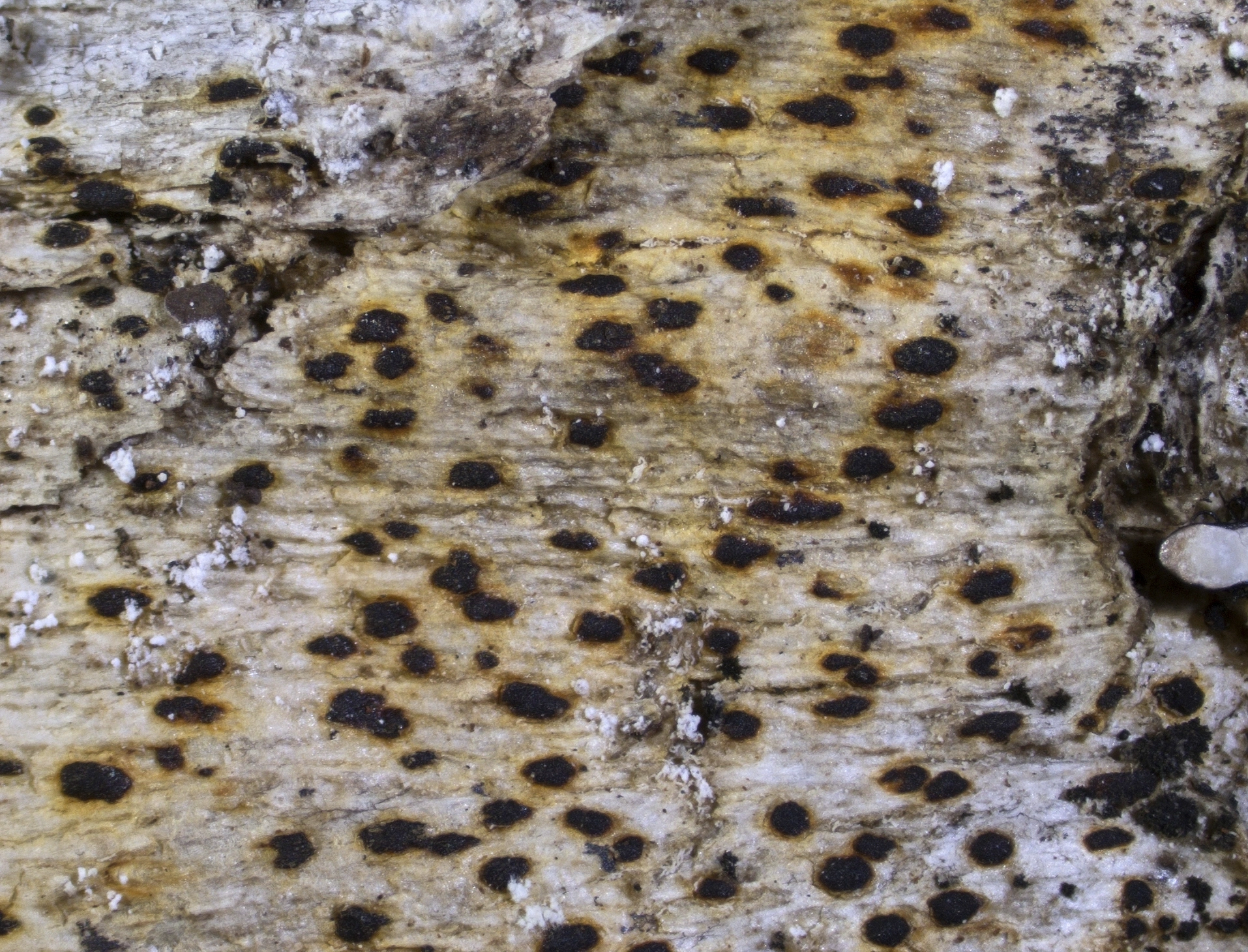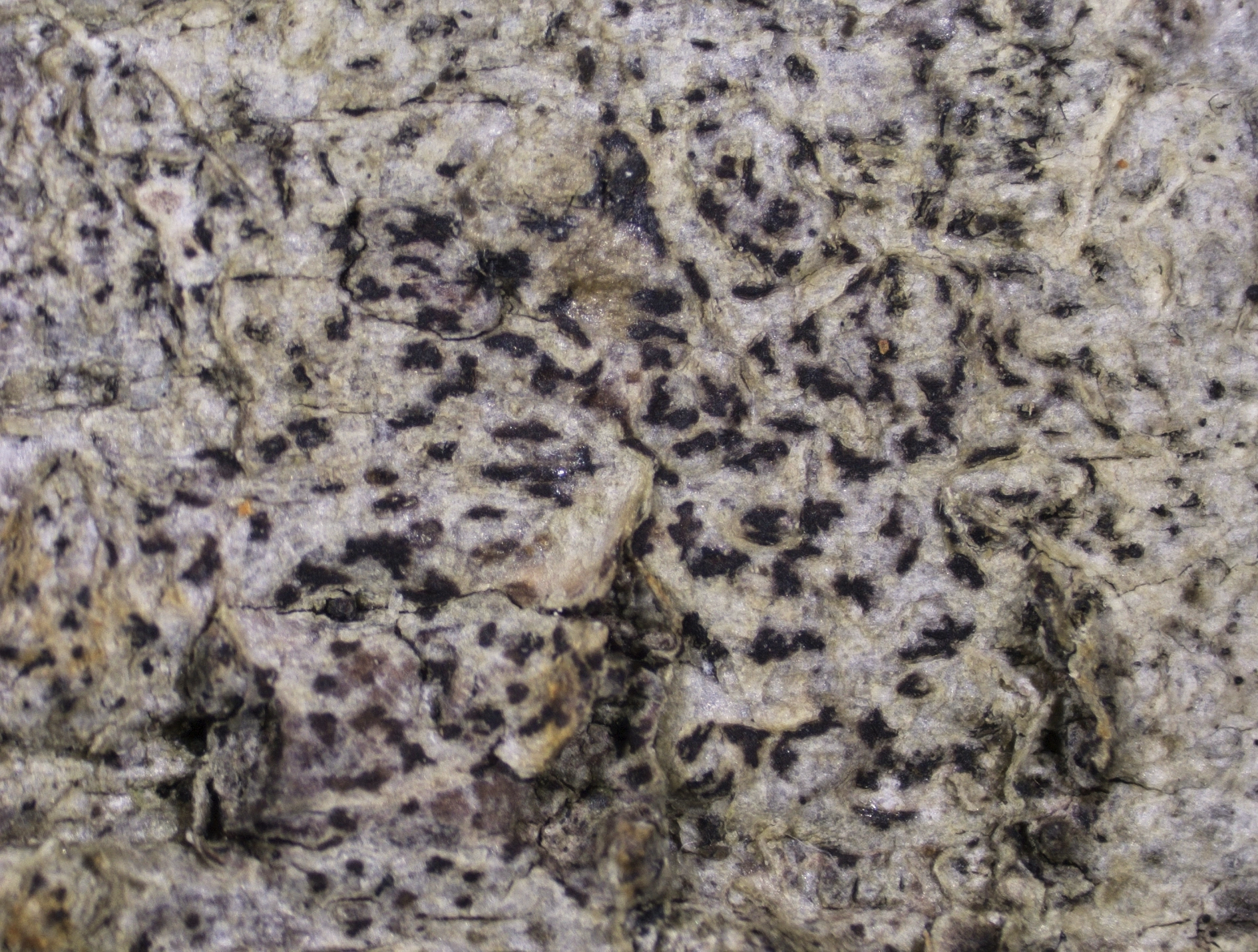Arthonia vinosa
Arthonia vinosa collected from an old Sorbus aucuparia at Glomsetmarka - Ørnakken in Ålesund (O-L-20928).
Arthonia vinosa is a species of old forests, woodlands and agricultural landscape. It is easily identified by large maculate, orange-brown to brown-black apothecia on an olive-grey thallus with trentepohlioid photobiont, and often distinct patches of an orange-yellow pigment. The 1-septate spores are brown and warted when old.
- Innhold
- Description
- Ecology
- Distribution in Norway and the Nordic countries
- Global distribution
- Similar species
Description
Thallus
The thin thallus is light grey to pale fawn and usually stained orange-yellow in more or less extensive patches. It is smooth, powdery or scurfy-granular, and immersed in the substrate to superficial. The margin is not determinate. The photobiont is a species of the family Trentepohliaceae.
Fruitbodies
The apothecia are maculate, usually distinctly raised over the thallus, orange-brown to brown-black, and without pruina. They are more or less convex, irregularly rounded, 0.2–0.6 mm in size and 70–140 μm tall.
The epithecium is indistinct.
The hymenium is orange to red and 30–40 μm tall.
The hypothecium is orange to orange-brown and up to 100 μm tall.
The paraphysoids are ca 1 μm wide. Their tips are usually not enlarged, but occasional pigment caps and plaques are observed.
The asci are clavate to obovoid, with stipe, 18–30 × 9–14 µm, and 8-spored.
The spores are colorless first, with a brown pigmentation and granular ornamentation when old. They are obovoid to ellipsoidal, 10–15 × 3.5–5 μm in size, and divided by 1 transverse septum.
Anamorph
The pycnidia are reddish-brown, immersed in the thallus, and 40–60 µm in size. The wall is reddish- to orange-brown. The rod-shaped conidia are 3.5–6 × ca 1 μm large, and straight or slightly bent.
Chemistry
The orange-yellow pigment on the thallus reacts K+ purple. It does not react with C, KC, Pd, or UV (C–, K± purple, KC–, Pd–, UV–). The anthraquinone O-methylhaematommone has been detected by TLC.
The hymenium reacts I+ red and KI+ blue. A KI+ blue ring structure has been observed in the asci.
The orange to red pigment in the apothecia and in the wall of the pycnidia dissolves with purple to magenta solution in K.
Arthonia vinosa collected south of Korpen in Larvik (O-L-25603).
Ecology
Arthonia vinosa is a frequent species in the interior of old-growth deciduous and coniferous forests and woodlands. It is also found on old trees in ancient agricultural landscape and parklands. The species typically grows on the lower tree trunks and towards the bases of deciduous and coniferous trees with acidic bark, where it often occurs in sheltered niches and places protected from rain. It also occurs on decaying bark and on wood. Arthonia vinosa is a lowland species that is most often recorded below 500 m elevation. Common host trees in Norway are birch (Betula spp.), oak (Quercus spp.), and Norway spruce (Picea abies). Other reported host trees include alder (Alnus spp.), aspen (Populus tremula), common hazel (Corylus avellana), common yew (Taxus baccata), European ash (Fraxinus excelsior), European beech (Fagus sylvatica), goat willow (Salix caprea), rowan (Sorbus aucuparia), small-leaved lime (Tilia cordata), and wych elm (Ulmus glabra).
Distribution in Norway and the Nordic countries
Arthonia vinosa occurs throughout Norway but is less common in northern Nordland and Troms og Finnmark. It has been reported up to Nordreisa municipality. In the Nordic countries, it is further known from Denmark, Finland and Sweden.
Global distribution
Outside the Nordic Countries, A. vinosa is widely distributed in submediterranean to southern boreal climates in Europe and North America. It is further reported from central and eastern Siberia and from Australasia.
Arthonia vinosa collected from an old Ulmus glabra at Hassel N in Indre Fosen (O-L-176917).
Similar species
Small individuals of Arthonia vinosa can be confused with morphs of Arthonia didyma having K+ purple pigments in the apothecia. The latter species has thinner fleck-like apothecia, 0.1–0.5 mm in size and up to 70 µm tall, that are often elongated or even indistinctly branched. The apothecia of A. didyma further often grow in distinct swarm-like aggregations on a pale fawn to olive-grey thallus. The spores are slightly larger than in A. vinosa, 12–18 × 5–8 µm in size.
Small individuals of Diarthonis spadicea differ by the usually less convex apothecia and smaller spores, 7–11 × 3–4 µm in size, that are not brown and warted when old. The red apothecial pigment does not dissolve in K solution.
Literature
Cannon P, Ertz D, Frisch A, Aptroot A, Chambers S, Coppins BJ, Sanderson N, Simkin J and Wolseley P (2020). Arthoniales: Arthoniaceae. Revisions of British and Irish Lichens 1: 1–48.
Elix JA. McCarthy PM, Kantvilas G and Archer AW (2019). Additional lichen records from Australia 85. Australasian Lichenology 84: 55–72.
Wirth V, Hauck M and Schultz M (2013). Die Flechten Deutschlands, vol. 1+2. Ulmer, Stuttgart. 1244s.




